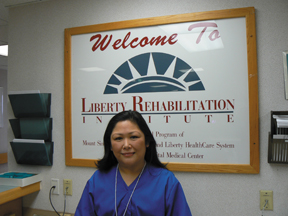In 2006, Darlene Liptai’s family took her to Meadowlands Hospital Medical Center after the 33-year-old had an asthma attack and wasn’t able to breathe on her own. She had to be placed on a respirator and put into a drug-induced coma.
Still, her family figured she’d quickly be stabilized and released in a matter of days. They were wrong.
While in the coma, Liptai had a stroke, followed by a heart attack two days later. When she emerged from the coma, Liptai was completely paralyzed on the left side of her body. Liptai, a resident of Secaucus, said she remembered being admitted to the hospital. Her next recollection was of doctors telling her she might never walk again.
“I remember being in shock, not believing what had happened,” Liptai said in an interview last week. “Once everything sunk in, I remember being in a deep hole, being in a deep place for a long time because you just can’t believe something like this has happened.”
Doctors told Liptai her prognosis for recovery was good because of her age, but they also stressed that much of her recovery was in her own hands.
Relearning the basics
When Liptai was released from the hospital’s intensive care unit, she was transferred to its rehabilitation center.
In rehab, Liptai worked about five hours a day, one-on-one, with an occupational therapist and a physical therapist. Her regimen was broken up into one-hour or 90-minute sessions spread throughout the day.
“I had to relearn how to do everything on my left hemisphere,” she recalled.
Her therapy, she added, literally began with one finger.
“I would try to extend or control one finger on my left hand,” she said. “Then I’d work up to two fingers. After I could move my fingers, next I’d try to control the entire hard, the whole arm.”
By the time she was released from the hospital, she had regained her balance, was able to walk with a cane, and could use steps in her home. But it was still another 18 months before Liptai felt she had really recovered from her ordeal.
“I wanted to give back to the hospital immediately after I left here,” Liptai said, speaking from the hospital’s third floor rehabilitation unit, where she was volunteering. “But I wasn’t in any condition to do that until last summer.”
Back where she started
Liptai now volunteers five hours a week at the hospital each Friday. During the rest of the week she and her husband own and operate an online wholesale business.
“LibertyHealth [the company that runs Meadowlands Hospital] is where I recovered and regained my strength,” said Liptai, “which is why I came back to volunteer here.”
She specifically asked to work in the rehabilitation unit because, she said, “I felt like I’d have more impact here.” In general, she’s on hand to assist the therapists and other volunteers with anything that needs to be done in the unit.
People in rehab can range from stroke patients to car accident survivors, people dealing with multiple sclerosis, and patients recovering from knee or hip replacement surgery. The unit can have as many as 30 patients when the hospital is busy.
She also acts as a sounding board for people who are now beginning the journey she has already traveled.
“Women in their 40s who’ve had strokes are most responsive to my story and my own recovery,” said Liptai, who is now considering a career in the health care field, possibly as a respiratory assistant, as a result of her volunteer work with patients.
“Being of service to others is the best gift you can give yourself,” Liptai noted. “It’s about getting to know yourself and seeing how much you can get out of yourself.”
30-year volunteers
Over the course of a year, Meadowlands Hospital has roughly 180 volunteers, with about 120 of them being “core volunteers,” according to Community Services Director Georgine Gallo, who runs the hospital’s volunteer program. Some people, she said, have been volunteers at the hospital for 30 years or longer.
The hospital’s pool of volunteers comes from across Hudson County, not just Secaucus. Gallo said she has volunteers from Jersey City, Union City, North Bergen, and West New York.
“I’m getting inundated with children [ages 14 to 18] now, which is wonderful,” said Gallo. “Either they’re doing it as a requirement for school, or their parents are making them do it. Because they’ve been exposed to volunteering at a young age, and they’ve experienced how it feels to volunteer, they’ll return to it later on in their lives.”
Prospective volunteers are required to submit an application and two references. Gallo interviews candidates, who are also given criminal background checks and a test for tuberculosis.
Volunteers get an orientation that includes information on patient confidentiality regulations. Those who will be working with patients directly are given additional training.
“Volunteering here has made me want to do it more,” Liptai said, “not just here, but wherever I’m needed.”
If you are interested in volunteering at Meadowlands Hospital, call Georgine Gallo at (201) 392-3266.
